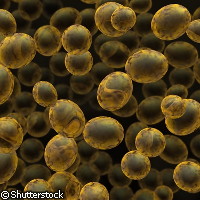How yeast cells use shmoos to schmooze
Men and women usually know very quickly after meeting if they are attracted to each other, and it seems that yeast often works in the same way. A new study by Canadian and UK researchers shows that yeast cells decide if they want to mate within two minutes of encountering each other. The findings, published in the journal Nature, could be helpful for scientists studying how cancer cells and stem cells develop. As single-cell microbes, yeasts are often used to study how cells work. Yeasts usually reproduce asexually by a process called 'budding', which involves a part of the cell being pinched off and developing into an identical cell. Sometimes, however, yeast cells reproduce sexually by mating. This occurs when one cell of each sex split off of the main cell, join together, mate and then move apart again. This process involves producing a nodule, called a shmoo, which the cells use to join together. The process of shmooing takes about two hours. The research team from Imperial College London and the University of Edinburgh, UK, and the Université de Montréal and McGill University, both in Canada, found that a yeast cell's decision to mate is controlled by the chemical change of a single protein. This change occurs within two minutes of the cell detecting the presence of a pheromone produced by an opposite sex cell. The team found that for the mating process to be initiated, the pheromone must be at a critical concentration around the yeast cell. If this level is not reached, the yeast cell will continue to reproduce asexually. 'Shmooing is a very energy-intensive process for yeast cells,' explained Dr Vahid Shahrezaei from Imperial College London. 'We think this switching process at a certain pheromone concentration may have evolved to make sure the cells only get prepared for sexual reproduction if a mate is sufficiently close enough and able to mate.' The researchers used a mathematical model to investigate how the mating urge is switched on and off in yeast cells. This included using experimental data about concentrations of pheromones around the yeast cell and different proteins crucial for the process to begin. Dr Shahrezaei said, 'Yeast cells live in a very noisy environment - they are surrounded by different chemicals, including pheromones and food, and their own machinery inside the cell produces lots of biomolecules that interact with each other. We wanted to see how cells make sense of this noisy environment and work out what is happening at a molecular level to make an important decision like mating. 'By combining experiments and mathematical modelling that take lots of different factors into consideration, we have been able to show exactly what is happening inside a yeast cell to make it decide whether to mate with another cell. We also showed that the mechanism that leads the cells to make their decision is very robust, meaning it is not affected by molecular noise in the environment,' he added. The researchers believe that their mathematical model could be used to help develop new drugs and therapies, as it can detect the triggers that lead to changes in cells, for example normal cells becoming cancerous. Yeast and mammal cells contain many of the same proteins and they work in a chain reaction to generate cell changes. 'Although yeast is dramatically different from people at a molecular and cellular level, we have a lot in common,' said lead author of the study Dr Stephen Michnick from the Université de Montréal. 'The same molecules that create the switching decision in yeast are found in very similar forms in human cells. Similar switching decisions to those made by yeast are made by stem cells during embryonic development and become dysfunctional in cancers.'
Countries
Canada, United Kingdom



